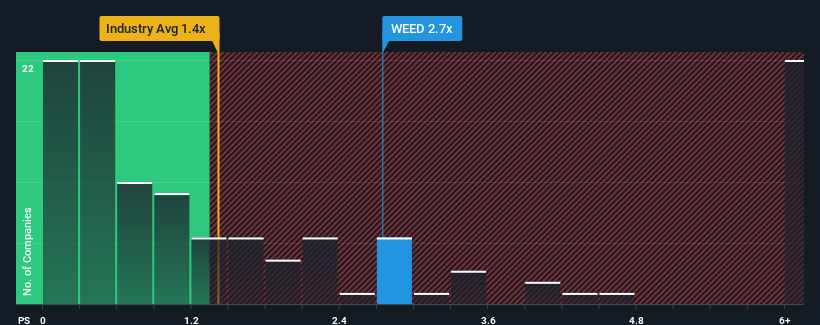Canopy Growth Corporation's (TSE:WEED) 77% Share Price Surge Not Quite Adding Up
Canopy Growth Corporation (TSE:WEED) shareholders have had their patience rewarded with a 77% share price jump in the last month. Not all shareholders will be feeling jubilant, since the share price is still down a very disappointing 40% in the last twelve months.
Following the firm bounce in price, you could be forgiven for thinking Canopy Growth is a stock not worth researching with a price-to-sales ratios (or "P/S") of 2.7x, considering almost half the companies in Canada's Pharmaceuticals industry have P/S ratios below 1.4x. Although, it's not wise to just take the P/S at face value as there may be an explanation why it's as high as it is.
Check out our latest analysis for Canopy Growth

How Has Canopy Growth Performed Recently?
Canopy Growth hasn't been tracking well recently as its declining revenue compares poorly to other companies, which have seen some growth in their revenues on average. It might be that many expect the dour revenue performance to recover substantially, which has kept the P/S from collapsing. However, if this isn't the case, investors might get caught out paying too much for the stock.
If you'd like to see what analysts are forecasting going forward, you should check out our free report on Canopy Growth.What Are Revenue Growth Metrics Telling Us About The High P/S?
There's an inherent assumption that a company should outperform the industry for P/S ratios like Canopy Growth's to be considered reasonable.
Taking a look back first, the company's revenue growth last year wasn't something to get excited about as it posted a disappointing decline of 1.2%. As a result, revenue from three years ago have also fallen 28% overall. Accordingly, shareholders would have felt downbeat about the medium-term rates of revenue growth.
Turning to the outlook, the next three years should bring diminished returns, with revenue decreasing 2.4% per year as estimated by the ten analysts watching the company. Meanwhile, the broader industry is forecast to expand by 8.0% per annum, which paints a poor picture.
In light of this, it's alarming that Canopy Growth's P/S sits above the majority of other companies. Apparently many investors in the company reject the analyst cohort's pessimism and aren't willing to let go of their stock at any price. There's a very good chance these shareholders are setting themselves up for future disappointment if the P/S falls to levels more in line with the negative growth outlook.
What Does Canopy Growth's P/S Mean For Investors?
The large bounce in Canopy Growth's shares has lifted the company's P/S handsomely. Using the price-to-sales ratio alone to determine if you should sell your stock isn't sensible, however it can be a practical guide to the company's future prospects.
For a company with revenues that are set to decline in the context of a growing industry, Canopy Growth's P/S is much higher than we would've anticipated. Right now we aren't comfortable with the high P/S as the predicted future revenue decline likely to impact the positive sentiment that's propping up the P/S. Unless these conditions improve markedly, it'll be a challenging time for shareholders.
Don't forget that there may be other risks. For instance, we've identified 3 warning signs for Canopy Growth (2 are potentially serious) you should be aware of.
If strong companies turning a profit tickle your fancy, then you'll want to check out this free list of interesting companies that trade on a low P/E (but have proven they can grow earnings).
New: AI Stock Screener & Alerts
Our new AI Stock Screener scans the market every day to uncover opportunities.
• Dividend Powerhouses (3%+ Yield)
• Undervalued Small Caps with Insider Buying
• High growth Tech and AI Companies
Or build your own from over 50 metrics.
Have feedback on this article? Concerned about the content? Get in touch with us directly. Alternatively, email editorial-team (at) simplywallst.com.
This article by Simply Wall St is general in nature. We provide commentary based on historical data and analyst forecasts only using an unbiased methodology and our articles are not intended to be financial advice. It does not constitute a recommendation to buy or sell any stock, and does not take account of your objectives, or your financial situation. We aim to bring you long-term focused analysis driven by fundamental data. Note that our analysis may not factor in the latest price-sensitive company announcements or qualitative material. Simply Wall St has no position in any stocks mentioned.
About TSX:WEED
Canopy Growth
Engages in the production, distribution, and sale of cannabis, hemp, and cannabis-related products in Canada, Germany, and Australia.
Excellent balance sheet with slight risk.
Similar Companies
Market Insights
Community Narratives



